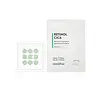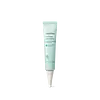What's inside
What's inside
 Key Ingredients
Key Ingredients

 Benefits
Benefits

 Concerns
Concerns

 Ingredients Side-by-side
Ingredients Side-by-side

Trehalose
HumectantSodium Hyaluronate
HumectantCellulose Gum
Emulsion StabilisingGlycerin
HumectantPolyglyceryl-10 Laurate
Skin ConditioningGlycine Soja Oil
EmollientAllantoin
Skin ConditioningDipotassium Glycyrrhizate
HumectantAdenosine
Skin ConditioningRetinol
Skin ConditioningMadecassoside
AntioxidantHyaluronic Acid
HumectantSalicylic Acid
MaskingWater
Skin ConditioningAsiaticoside
AntioxidantMadecassic Acid
Skin ConditioningAsiatic Acid
Skin ConditioningBHT
AntioxidantPropanediol
Solvent1,2-Hexanediol
Skin ConditioningCentella Asiatica Flower/Leaf/Stem Extract
Skin ConditioningEthylhexylglycerin
Skin ConditioningDisodium EDTA
Trehalose, Sodium Hyaluronate, Cellulose Gum, Glycerin, Polyglyceryl-10 Laurate, Glycine Soja Oil, Allantoin, Dipotassium Glycyrrhizate, Adenosine, Retinol, Madecassoside, Hyaluronic Acid, Salicylic Acid, Water, Asiaticoside, Madecassic Acid, Asiatic Acid, BHT, Propanediol, 1,2-Hexanediol, Centella Asiatica Flower/Leaf/Stem Extract, Ethylhexylglycerin, Disodium EDTA
Water
Skin ConditioningButylene Glycol
HumectantCyclopentasiloxane
EmollientAlcohol
AntimicrobialGlycerin
HumectantCyclohexasiloxane
EmollientTorreya Nucifera Seed Oil
EmollientHydroxyethyl Acrylate/Sodium Acryloyldimethyl Taurate Copolymer
Emulsion StabilisingPEG-240/Hdi Copolymer Bis-Decyltetradeceth-20 Ether
StabilisingPolysorbate 20
EmulsifyingPropanediol
SolventSalicylic Acid
MaskingDimethicone
EmollientDimethiconol
EmollientAmmonium Acryloyldimethyltaurate/Vp Copolymer
Potassium Hydroxide
BufferingDimethicone/Vinyl Dimethicone Crosspolymer
Skin ConditioningDipotassium Glycyrrhizate
HumectantMadecassoside
AntioxidantGlyceryl Caprylate
EmollientRosa Centifolia Flower Extract
AstringentXanthan Gum
EmulsifyingDisodium EDTA
Dextrin
AbsorbentTheobroma Cacao Extract
Skin ConditioningCamellia Sinensis Leaf Extract
AntimicrobialOpuntia Coccinellifera Fruit Extract
Skin ConditioningCamellia Japonica Leaf Extract
Skin ConditioningBeta-Glucan
Skin ConditioningOrchid Extract
Skin ConditioningCitrus Unshiu Peel Extract
MaskingPhenoxyethanol
PreservativeParfum
MaskingWater, Butylene Glycol, Cyclopentasiloxane, Alcohol, Glycerin, Cyclohexasiloxane, Torreya Nucifera Seed Oil, Hydroxyethyl Acrylate/Sodium Acryloyldimethyl Taurate Copolymer, PEG-240/Hdi Copolymer Bis-Decyltetradeceth-20 Ether, Polysorbate 20, Propanediol, Salicylic Acid, Dimethicone, Dimethiconol, Ammonium Acryloyldimethyltaurate/Vp Copolymer, Potassium Hydroxide, Dimethicone/Vinyl Dimethicone Crosspolymer, Dipotassium Glycyrrhizate, Madecassoside, Glyceryl Caprylate, Rosa Centifolia Flower Extract, Xanthan Gum, Disodium EDTA, Dextrin, Theobroma Cacao Extract, Camellia Sinensis Leaf Extract, Opuntia Coccinellifera Fruit Extract, Camellia Japonica Leaf Extract, Beta-Glucan, Orchid Extract, Citrus Unshiu Peel Extract, Phenoxyethanol, Parfum
 Reviews
Reviews

Ingredients Explained
These ingredients are found in both products.
Ingredients higher up in an ingredient list are typically present in a larger amount.
Dipotassium Glycyrrhizate comes from licorice root.
Extracts of licorice have demonstrated to have antibacterial, anti‐inflammatory, antiviral, antioxidant properties.
One component, glabridin, has extra potent antioxidant and soothing properties. It has also been found to block pigmentation from UVB rays in guinea pigs.
Licorice Root also contains a flavonoid. Flavonoids are a natural substance from in plants. Flavonoids also have antioxidant properties.
Another component, glycyrrhizin, has been found to have anti-inflammatory and antimicrobial benefits. This may make licorice root extract effective at treating acne. However, more research is needed to support this.
Liquiritin is one of the flavone compounds found in licorice. It has been found to help lighten skin by preventing tyrosinase from reacting with tyrosine. When the two react, protein is converted to melanin. Melanin is the substance in your body that gives your features pigmentation.
Licorice root is native to Southern Europe and Asia. It has been used in traditional Chinese medicine to help with respiratory issues.
Learn more about Dipotassium GlycyrrhizateDisodium EDTA plays a role in making products more stable by aiding other preservatives.
It is a chelating agent, meaning it neutralizes metal ions that may be found in a product.
Disodium EDTA is a salt of edetic acid and is found to be safe in cosmetic ingredients.
Learn more about Disodium EDTAGlycerin is already naturally found in your skin. It helps moisturize and protect your skin.
A study from 2016 found glycerin to be more effective as a humectant than AHAs and hyaluronic acid.
As a humectant, it helps the skin stay hydrated by pulling moisture to your skin. The low molecular weight of glycerin allows it to pull moisture into the deeper layers of your skin.
Hydrated skin improves your skin barrier; Your skin barrier helps protect against irritants and bacteria.
Glycerin has also been found to have antimicrobial and antiviral properties. Due to these properties, glycerin is often used in wound and burn treatments.
In cosmetics, glycerin is usually derived from plants such as soybean or palm. However, it can also be sourced from animals, such as tallow or animal fat.
This ingredient is organic, colorless, odorless, and non-toxic.
Glycerin is the name for this ingredient in American English. British English uses Glycerol/Glycerine.
Learn more about GlycerinMadecassoside comes from the super popular skin-soothing ingredient, Centella asiatica. It is one of four active compounds found in the extract of Centella Asiatica.
Madecassoside has antioxidant, anti-inflammatory, and hydrating properties. It contains fatty acids, amino acids, beta-carotene, and phytochemicals.
One study found using Madecassoside with ascorbic acid helped reduce the signs of aging and improved skin hydration.
Learn more about MadecassosidePropanediol is an all-star ingredient. It softens, hydrates, and smooths the skin.
It’s often used to:
Propanediol is not likely to cause sensitivity and considered safe to use. It is derived from corn or petroleum with a clear color and no scent.
Learn more about PropanediolSalicylic Acid (also known as beta hydroxy acid or BHA) is a well-known ingredient for treating skin that struggles with acne and clogged pores. It exfoliates both the skin's surface and deep within the pores to help clear out buildup, control oil, and reduce inflammation.
Unlike AHAs (alpha hydroxy acids), salicylic acid is oil-soluble. This allows it to penetrate into pores which makes it especially effective for treating blackheads and preventing future breakouts.
Salicylic acid is also known for its soothing properties. It has a similar structure to aspirin and can calm inflamed or irritated skin, making it a good option for acne-prone skin that is also sensitive.
Concentrations of 0.5-2% are recognized by the U.S. FDA as an over-the-counter topical acne product.
It can cause irritation and/or dryness if one's skin already has a compromised moisture barrier, so it's best to focus on repairing that before introducing this ingredient into your routine.
While salicylic acid does not increase sun sensitivity, it’s still important to wear sunscreen daily to protect your skin.
If you are looking for the ingredient called BHA or Butylated Hydroxyanisole, click here.
Learn more about Salicylic AcidWater. It's the most common cosmetic ingredient of all. You'll usually see it at the top of ingredient lists, meaning that it makes up the largest part of the product.
So why is it so popular? Water most often acts as a solvent - this means that it helps dissolve other ingredients into the formulation.
You'll also recognize water as that liquid we all need to stay alive. If you see this, drink a glass of water. Stay hydrated!
Learn more about Water